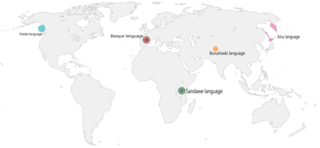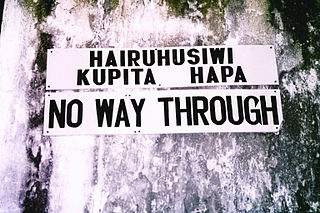Related Research Articles

International Sign (IS) is a pidgin sign language which is used in a variety of different contexts, particularly as an international auxiliary language at meetings such as the World Federation of the Deaf (WFD) congress, in some European Union settings, and at some UN conferences, at events such as the Deaflympics, the Miss & Mister Deaf World, and Eurovision, and informally when travelling and socialising.

A language isolate is a language that has no demonstrable genetic relationship with another language. Basque in Europe, Ainu in Asia, Sandawe in Africa, Haida and Zuni in North America, Kanoê in South America, and Tiwi in Australia are all examples of language isolates. The exact number of language isolates is yet unknown due to insufficient data on several languages.
Taiwan Sign Language is the sign language most commonly used by the deaf and hard of hearing in Taiwan.

Deaf culture is the set of social beliefs, behaviors, art, literary traditions, history, values, and shared institutions of communities that are influenced by deafness and which use sign languages as the main means of communication. When used as a cultural label, especially within the culture, the word deaf is often written with a capital D and referred to as "big D Deaf" in speech and sign. When used as a label for the audiological condition, it is written with a lower case d. Carl G. Croneberg coined the term "Deaf Culture" and he was the first to discuss analogies between Deaf and hearing cultures in his appendices C/D of the 1965 Dictionary of American Sign Language.

Irish Sign Language is the sign language of Ireland, used primarily in the Republic of Ireland. It is also used in Northern Ireland, alongside British Sign Language (BSL). Irish Sign Language is more closely related to French Sign Language (LSF) than to BSL, though it has influence from both languages. It has influenced sign languages in Australia and South Africa, and has little relation to either spoken Irish or English. ISL is unique among sign languages for having different gendered versions due to men and women being taught it at different schools all over Ireland.

South African Sign Language is the primary sign language used by deaf people in South Africa. The South African government added a National Language Unit for South African Sign Language in 2001. SASL is not the only manual language used in South Africa, but it is the language that is being promoted as the language to be used by the Deaf in South Africa, although Deaf peoples in South Africa historically do not form a single group.
Flemish Sign Language is a deaf sign language of Belgium. It is closely related to French Belgian Sign Language, but they are now generally recognized as distinct languages. VGT is estimated to include around 6,000 sign-language users.

Dutch Sign Language is the predominant sign language used by deaf people in the Netherlands.

Thai Sign Language, or Modern Standard Thai Sign Language (MSTSL), is the national sign language of Thailand's deaf community and is used in most parts of the country by the 20 percent of the estimated 56,000 pre-linguistically deaf people who go to school.

Education in Tanzania is provided by both the public and private sectors, starting with pre-primary education, followed by primary, secondary ordinary, secondary advanced, and ideally, university level education. Free and accessible education is a human right in Tanzania. The Tanzanian government began to emphasize the importance of education shortly after its independence in 1961. Curriculum is standardized by level, and it is the basis for the national examinations. Achievement levels are important, yet there are various causes of children not receiving the education that they need, including the need to help families with work, poor accessibility, and a variety of learning disabilities. While there is a lack of resources for special needs education, Tanzania has committed to inclusive education and attention on disadvantaged learners, as pointed out in the 2006 Education Sector Review AIDE-MEMORE. The government's National Strategy for Growth and Reduction of Poverty in 2005 heavily emphasized on education and literacy.
Nepalese Sign Language or Nepali Sign Language (Nepali: नेपाली साङ्केतिक भाषा, romanized: Nēpālī Sāṅkētika Bhāṣā is the main sign language of Nepal. It is a partially standardized language based informally on the variety used in Kathmandu, with some input from varieties from Pokhara and elsewhere. As an indigenous sign language, it is not related to oral Nepali. The Nepali Constitution of 2015 specifically mentions the right to have education in Sign Language for the deaf. Likewise, the newly passed Disability Rights Act of 2072 BS defined language to include "spoken and sign languages and other forms of speechless language." in practice it is recognized by the Ministry of Education and the Ministry of Women, Children and Social Welfare, and is used in all schools for the deaf. In addition, there is legislation underway in Nepal which, in line with the UN Convention on the Rights of Persons with Disabilities which Nepal has ratified, should give Nepalese Sign Language equal status with the oral languages of the country.
The Japanese Sign Language (JSL) family is a language family of three sign languages:
Ebrahim Hussein is a Tanzanian playwright and poet. His first play, Kinjeketile (1969), written in Swahili, and based on the life of Kinjikitile Ngwale, a leader of the Maji Maji Rebellion, is considered "a landmark of Tanzanian theater". The play soon became one of the standard subjects for examinations in the Swahili language in Tanzania and Kenya. By 1981, it had been reprinted six times.

Tanzania is a multilingual country. There are many languages spoken in the country, none of which is spoken natively by a majority or a large plurality of the population. Swahili and English, the latter of which was inherited from colonial rule, are widely spoken as lingua francas. They serve as working languages in the country, with Swahili being the official national language. There are more speakers of Swahili than of English in Tanzania.
Egyptian Sign Language is a sign language used by members of the deaf community in Egypt.
Trinidad and Tobago Sign Language (TTSL), sometimes called Trinidadian or Trinbago Sign Language (TSL) is the indigenous deaf sign language of Trinidad and Tobago, originating in about 1943 when the first deaf school opened, the Cascade School for the Deaf. It is not used in deaf education, which has been the domain of American Sign Language since about 1974, when a philosophy of Total Communication replaced previous Oralist approaches. A mixture of TTSL and ASL is used in Deaf associations, with TTSL being used more heavily in informal situations. The younger generation does not know the language well, as they only learn ASL in school, but teachers are starting to switch over to TTSL.
NKo (ߒߞߏ) is a standardized unified koiné form of several Manding languages written in the NKo alphabet. It is used in Guinea, Guinea-Bissau, Mali, Ivory Coast, Burkina Faso and some other West African countries, primarily, but not exclusively, in written form, whereas in speech the different varieties of Manding are used: Maninka, Bambara, Dyula and others.

Black American Sign Language (BASL) or Black Sign Variation (BSV) is a dialect of American Sign Language (ASL) used most commonly by deaf African Americans in the United States. The divergence from ASL was influenced largely by the segregation of schools in the American South. Like other schools at the time, schools for the deaf were segregated based upon race, creating two language communities among deaf signers: black deaf signers at black schools and white deaf signers at white schools. As of the mid 2010s, BASL is still used by signers in the South despite public schools having been legally desegregated since 1954.
Deafness in Thailand refers to the population and culture of Deaf Hard of Hearing people in Thailand. Deafness in Thailand includes language emergence, organizations, healthcare, employment, schooling, and civil rights.
Martha A. S. Qorro is a linguist and an associate professor at the Centre for Communication Studies of the University of Dar es Salaam, known for her research into the use of the Kiswahili language as preferable language of instruction in Tanzania, and the Iraqw language.
References
- 1 2 Tanzanian Sign Language at Ethnologue (18th ed., 2015) (subscription required)
- ↑ Muzale, MRT (2004). Kamusi ya Lugha ya Alama ya Tanzania (LAT) / Tanzanian Sign Language (TSL) Dictionary. ISBN 9987-691-02-1.
- 1 2 LEE, J. C. (2012). They Have To See Us: An Ethnography of Deaf People in Tanzania. Unpublished dissertation, University of Colorado. https://scholar.colorado.edu/concern/graduate_thesis_or_dissertations/n009w2365
- 1 2 3 Rothe, A. (2020). Deaf People in Arusha (Tanzania) - Navigating through a Multilingual Education System and Expectations To “Fit in.” Unpublished master’s thesis, Universität Wien, Vienna (Austria). https://phaidra.univie.ac.at/detail/o:1392094.pdf
- ↑ "Documentation and description of the Tabora variety of Tanzanian Sign Language". Projects. Universiteit Leiden. Retrieved 25 October 2019.
- 1 2 Rothe, Andreas R. (2022). "Deaf People in Arusha (Tanzania): Experiences with a Multilingual Education System, Mainstream Society's Expectations, Deaf Spaces, and Identity". Sign Language Studies. 22 (4): 590–620. ISSN 0302-1475.
- ↑ "CoHU / Department". cohu.udsm.ac.tz. Retrieved 2024-05-26.